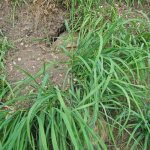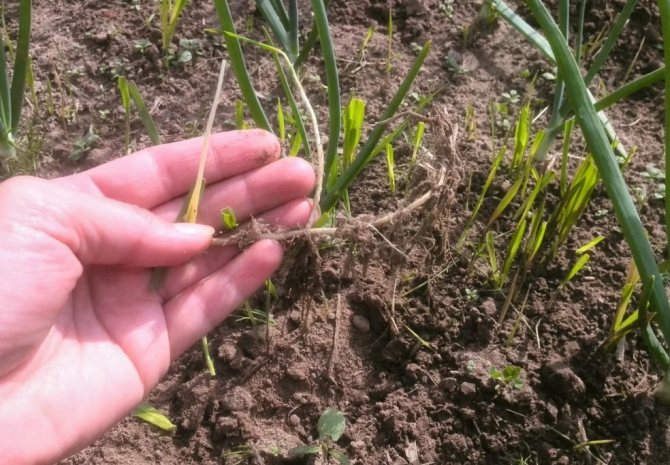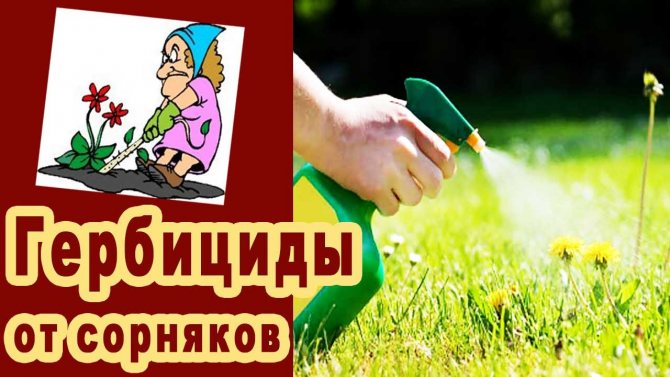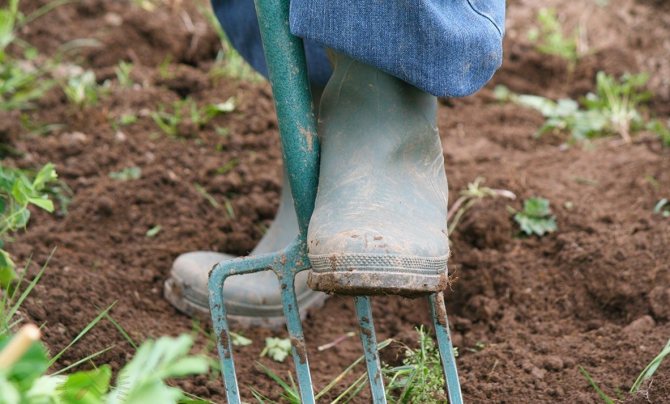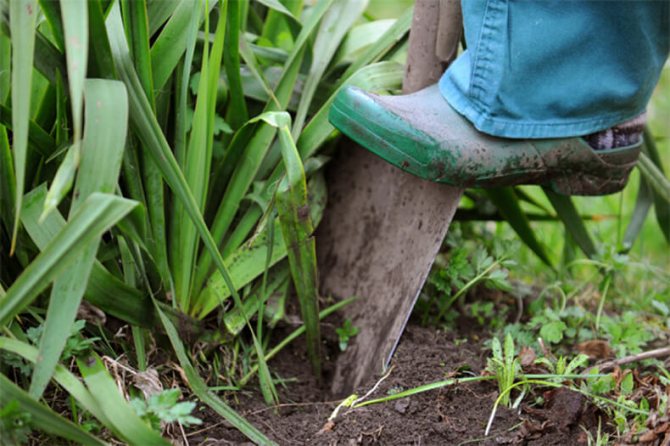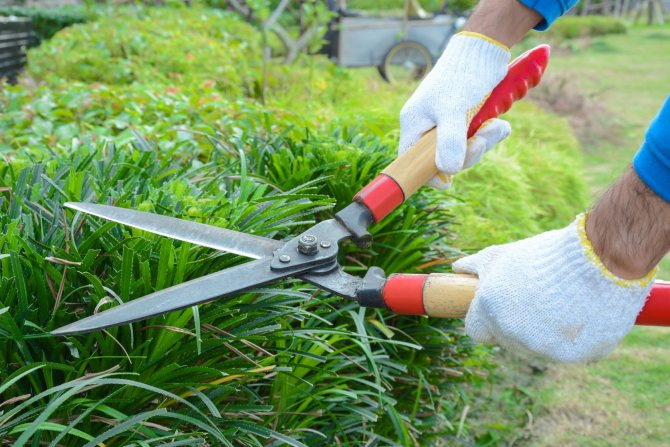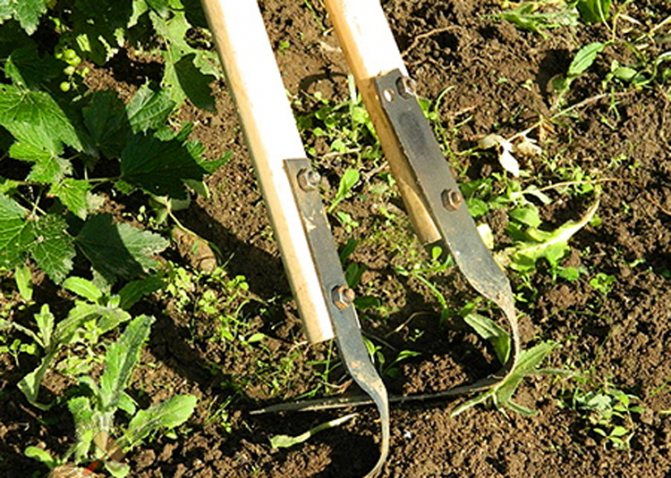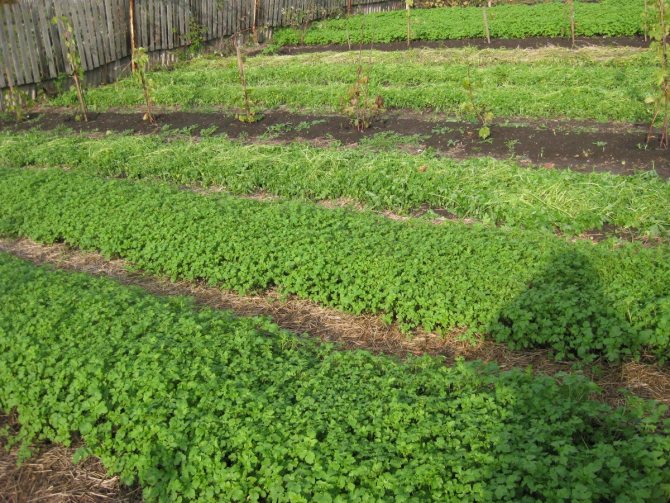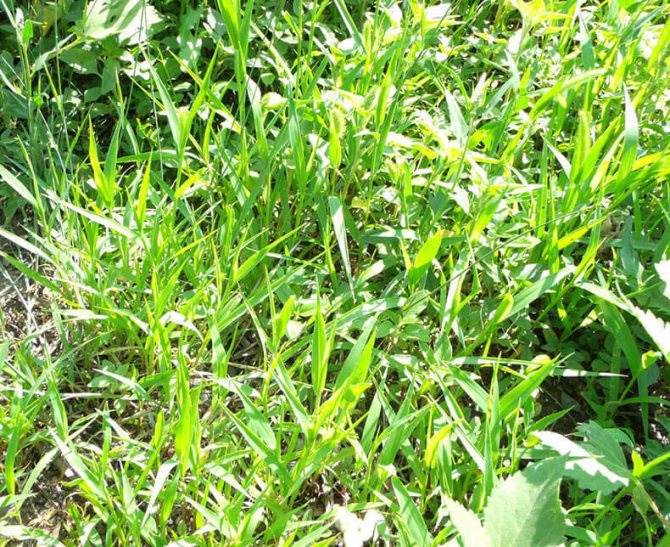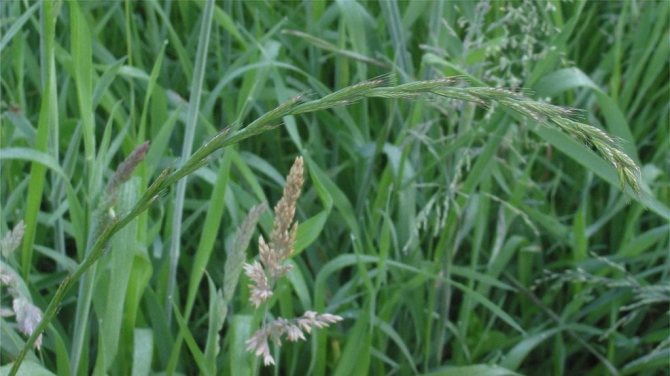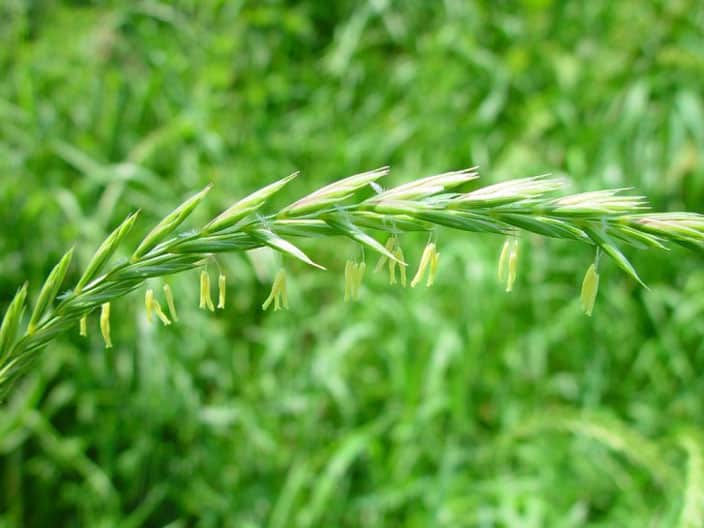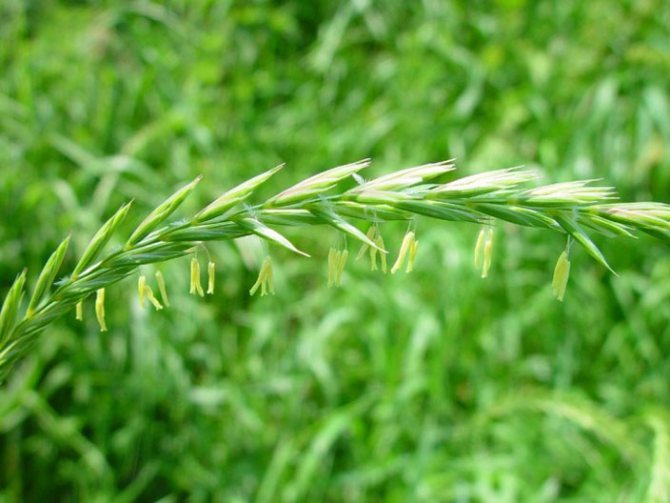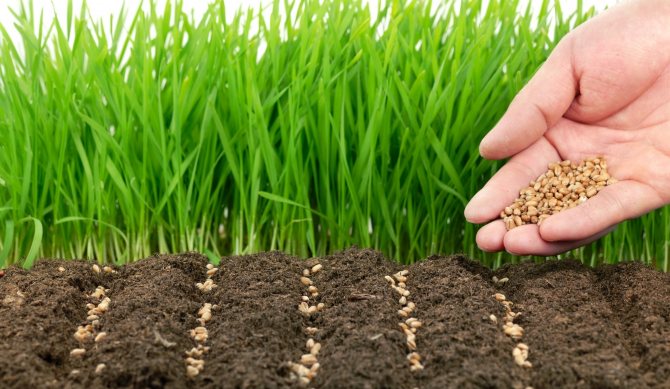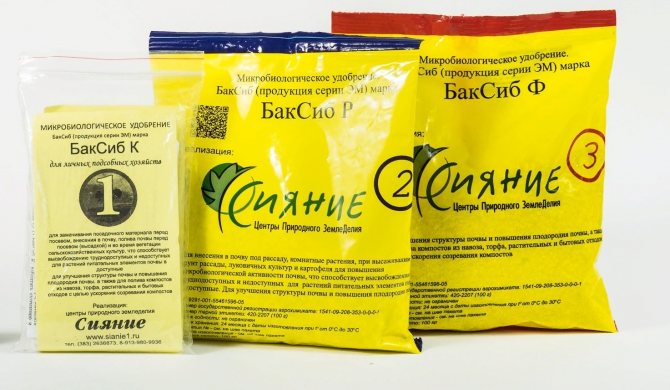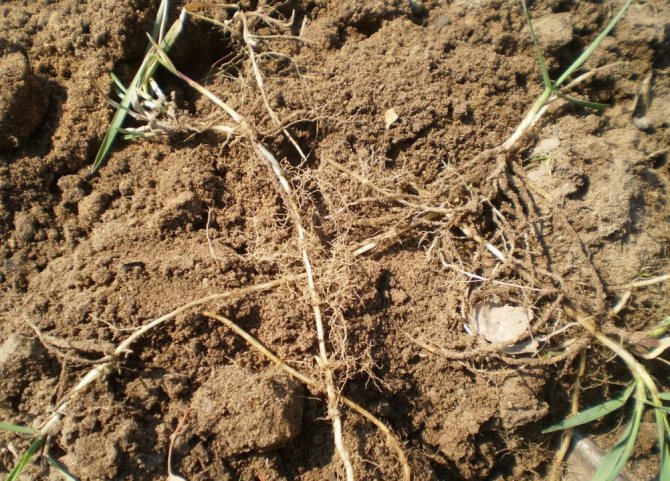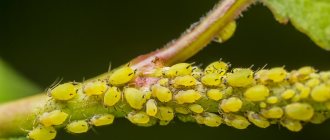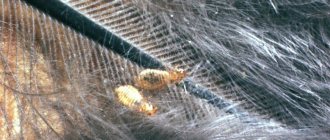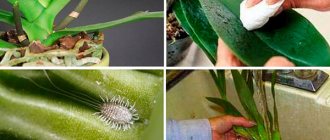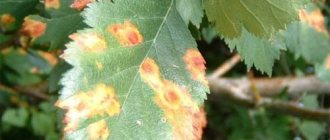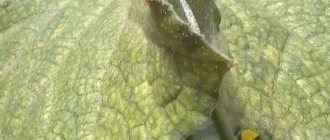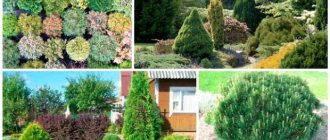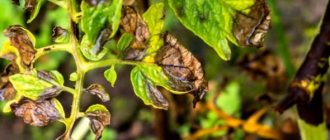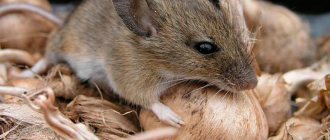What does wheatgrass weed look like?
Creeping wheatgrass is an unpretentious herb that grows in fields, vegetable gardens, meadows, wastelands, forest edges, along roads and near fences. This weed is rapidly propagated by seeds and rhizomes. Even the smallest part of it, on which a living bud is preserved, will eventually become a new plant. The rhizome of the plant is cordlike, creeping, up to 15 m long. It is located horizontally underground, and, in accordance with the type of soil, penetrates to a depth of 5-20 cm, forming branches and adventitious roots.
The branches located near the surface of the soil are bent upward and form new plant specimens. The rhizome is very thin, but it is fast growing and strong. It has the ability to pierce through potato tubers and wooden boards, the thickness of which does not exceed 3 cm. The color of the young roots is white, and the old ones are yellow-brown in color.
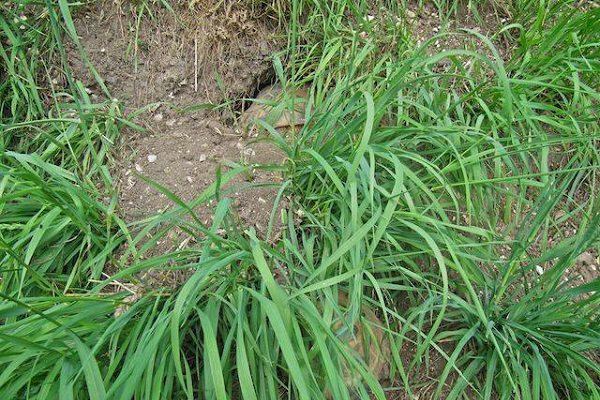
The rising stems of the weed can reach a height of 0.2-1.5 m. They have no pubescence, but inside they are hollow. Plants are characterized by the next leaf arrangement. The sheet itself, the length of which is 15-35 cm, and the width can reach 1 m, is quite flat and has a narrow-linear shape.
It shows parallel venation and roughness on the upper side. The color of the leaves can be green or bluish-green. Their vertical growth from the root, which partially covers the stem with its bases, forms the so-called leaf sheath.
Wheatgrass blooms from May to July. He has inconspicuous small flowers of yellow-green color. They are concentrated in the upper part of the stems and, in the amount of 4-10 pieces, are collected in spikelets, which form a complex spike (its length is 10-25 cm). Each flower has three stamens and one pistil.
Fruit ripening is observed in August-September. Each fruit is a small, up to 1 cm, hairy, membranous weevil, enclosed in a flower scale, fused with it. Each fruit contains one seed within it.
Useful properties of wheatgrass
Each plant has its own value in nature. Weeds are no exception; they also provide some benefits. Rhizomes and wheatgrass juice are often used in traditional medicine recipes. To do this, the roots are harvested in early spring or autumn and dried, and a healthy juice is made from the stems.
In ancient times, our ancestors made flour from dried rhizomes, from which they baked bread and delicious cakes. This flour is rich in polysaccharides, glycides, fructose, malic acid, levulose, carotene, vitamin C and other useful substances. A decoction made from rhizomes is a good diaphoretic, diuretic and expectorant. Among its other medicinal properties, the following can be distinguished:
- With its help, treat diseases of the stomach, liver, lungs, intestines, rheumatism, cystitis, and also remove stones from the gallbladder.
- Fresh squeezed juice is used to treat skin diseases, colds, osteochondrosis, bronchitis and pneumonia.
- The infusion of wheatgrass helps to cleanse of toxins and toxins, normalizes metabolic processes in the body, as a result of which weight is normalized, and helps to cleanse the skin.
- Wheat grass baths are used in the complex treatment of rickets, diarrhea and hemorrhoids.
In addition, the plant has a beneficial effect on the digestive system of animals, including cats and dogs. Also used as feed for cattle.
Weed damage
People are constantly fighting against creeping wheatgrass, since it harms cultivated crops. According to agronomists, only 8-10 units of this plant per square meter of grown winter wheat reduce its yield by about 5-8 centners per hectare. In addition, this weed has a negative effect on the soil. It absorbs nutrients, as a result of which the earth is depleted and very dry.
For example, in order to form 100-120 kg of seeds per hectare of area, wheatgrass uses several times more water than winter wheat. And for the formation of 6-7 tons of aboveground and underground parts of this weed from one hectare, it needs to take 45 kg of nitrogen, 70 kg of potassium and 30 kg of phosphorus from the ground.
How to deal with wheatgrass weed by mechanical means?
Agrotechnical methods are basic in the fight against wheatgrass. This is explained by the fact that mechanical destruction is the safest environmentally friendly and the most affordable option for owners of personal plots and vegetable gardens.


For the destruction of wheatgrass, the following agrotechnical methods are used:
- Tillage immediately after harvest, in the fall. Plowing should be carried out in stages: first, disking (processing depth - 8-12 cm), and then plowing to a depth of 24-27 cm. One and a half to three weeks after disking, it is necessary to re-process.
- Manual sampling of roots. This method is used exclusively in small areas with a slight overgrowth of weeds. To destroy it, you will need a pitchfork, since the rhizomes hit by the shovel are trimmed and remain in the ground. To dig up wheatgrass, the bush should be picked up with a pitchfork, pulled out, shaken off well and removed from the garden.
- Harrowing in the spring. In order to keep moisture in the plowed area, a harrowing procedure is necessary. It is carried out shortly before sowing vegetable crops, using a cultivator for work. With the help of its blades, the roots of the weed are trimmed and partially pulled out of the ground.
- Pruning shoots in the spring. With the regular implementation of this procedure, the plants are gradually depleted and after a while they die. It is worth noting that such work takes a lot of time, and in order to achieve good results, it must be done constantly, at intervals of 2-3 weeks.
- Crushing the root system with a cultivator. Root debris can cause young shoots to sprout, which can be removed by weeding. After this, it is necessary to control the possible growth of the remaining roots.
- Suffocation of wheatgrass. This procedure consists in laying out a "pillow" consisting of the remnants of vegetation. Its lower layer consists of tops and rough stems, and the upper layer contains wood ash interspersed with earth. Due to lack of air, the buds have no chance of germination.
- Darkening procedure. On an area with a large number of weeds, you need to spread a black plastic wrap and press it down with heavy objects on top. Due to the lack of sunlight, wheatgrass will die.
All of the above methods of how to remove wheatgrass weed on the site will be more effective if used in conjunction with chemicals.
Agrotechnical techniques
These methods of dealing with weeds are probably known to all gardeners, nevertheless, they can be effective in small areas with a certain perseverance, patience and hard work.
Read also: Gumboro disease (bursal): symptoms, methods of struggle


It was in the old days that the whole village usually fought with wheatgrass, and now, given the number of abandoned sites, we have to take measures ourselves to protect the borders from an intruder. This is easy to do if you do not have a very large area, digging into the ground from the side of the neighbors to a depth of 25-30 cm of strips of slate or any plastic to protect against the rhizomes of the plant.
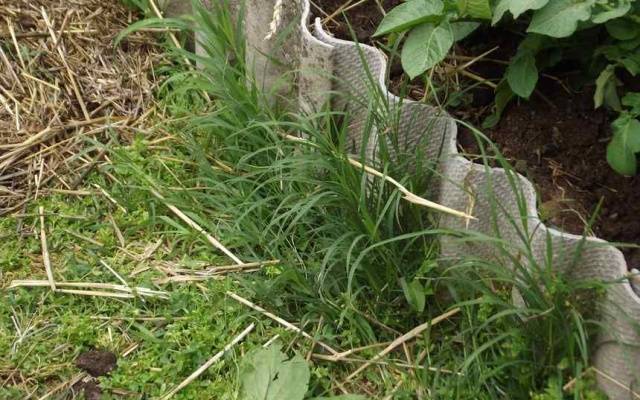

How to remove wheatgrass weed from the garden using green manure?
Often, siderat plants are used to combat annoying wheatgrass. This method of destroying weeds is the so-called organic cultivation. When sowing green manure on a land plot, its ecological state does not get worse, but on the contrary - after clearing of weeds, the soil improves. The most famous green manure plants are rapeseed, phacelia, buckwheat, lupine, clover, peas and rye.
Siderata are sown in shallow plowed soil about a month before planting the main crop or immediately after harvesting. After their growth, the root system of wheatgrass can no longer spread and is gradually forced out of the garden. Mowing and incorporating green manures into the soil contribute to soil aeration.
Herbicide application
If none of the above helps, or if you don't want to bother too much, then use chemicals. In stores, there is still no specific drug that adversely affects only wheatgrass, so herbicides remove not only it, but all other plants. The most popular remedy is Roundup, available in any garden store or nursery.
When you want to get rid of wheatgrass specifically, do not spray the garden with it, but lubricate its leaves with a brush dipped in the preparation.
There are other options for getting rid of harmful weeds. For example, pouring boiling water or vinegar on it. But they are not as effective as all those described in this article. Do not run your land, and then you will harvest a large harvest from it every year.
Wheat grass weed and the fight against it using folk methods
Over the years of fighting wheatgrass, people have come up with many effective ways to get rid of this plant. Many people use baking soda for this. With its help, you can destroy weed bushes by treating them with a strong solution of the substance.
You can also fight weeds with a blowtorch. However, this method is not very effective, because when weeds are burned out on the soil surface, the root system practically does not suffer.
A herbicidal soap that is easy to make on your own has worked well. It contains 15% vinegar (4 l), table salt (100 g) and any detergent (1 tsp). The resulting product is used as a poison against wheatgrass and other weeds. Some time after processing, they die.
Siderat rescuers
Some gardeners clean the plantations from wheatgrass with oats or rye. They sow overgrown areas with these crops, having previously dug up, but without choosing the rhizomes of the weed. Usually, cereals grow in ribbons, the distance between the rows is 15 cm.
A month and a half after planting, all the greens are cut off, cultivated and the site is again prepared for sowing. If rye and oats are grown in this way up to three times, there will never be wheatgrass in this place again. The method is applicable to both small and large areas.
Plants of the legume family, as well as corn and sunflowers, are suitable as siderates. The seeds are planted densely in a plowed field, and when the crops grow, they will suffocate the creeping wheatgrass.
Chemical control methods
Using chemicals to combat wheatgrass is a quick and effective way to get rid of them. When weeds are treated with systemic chemicals, they spread throughout the plant and have a detrimental effect on it.When choosing a herbicide, it is necessary to be guided by the goal that is planned to be achieved - the complete destruction of plants in the selected area or selective.
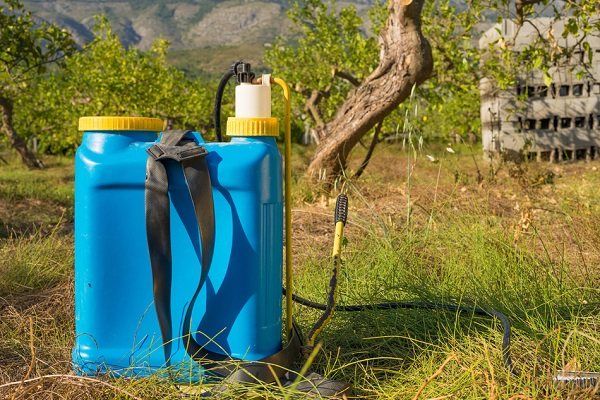

If the task is to deal with plants on the path or between parts of the paving slabs, preference should be given to herbicides of continuous action. And in large areas used for growing garden crops, treatment should be carried out with selective drugs that destroy certain types of weeds.
Manufacturers offer a huge selection of chemicals to combat wheatgrass. The most common and effective ones are Hurricane Forte, Tornado, Roundup, Glyfos, Agrokiller, Fuzalid Forte, Ground.
Despite the fact that chemicals in the fight against wheatgrass have proven to be effective, it must be remembered that when weeds are removed in this way, living soil and its inhabitants can be irreparably damaged. Cultivated plants growing on a plot of such land will be under the influence of these substances for a long time.
Agronomists advise not to use herbicides on the same site more often than once every 3 years. When working with chemicals, you should always use respirators, goggles, heavy clothing and gloves, thanks to which the used products do not come into contact with the skin.
It is important to remember that getting rid of weeds, including wheatgrass, is possible only under the condition of systematic control. Occasionally destroyed harmful vegetation will not bring the desired results.
Chemicals and EMs
If sparing folk methods do not bring results, they resort to radical measures of influence. In this case, the effect can be seen not in a week or a month, but immediately.
Herbicides kill the weed instantly, only before spraying you need to take care of your protection - you will need: special clothing, glasses, gloves.
Here are the most popular chemicals against wheatgrass:
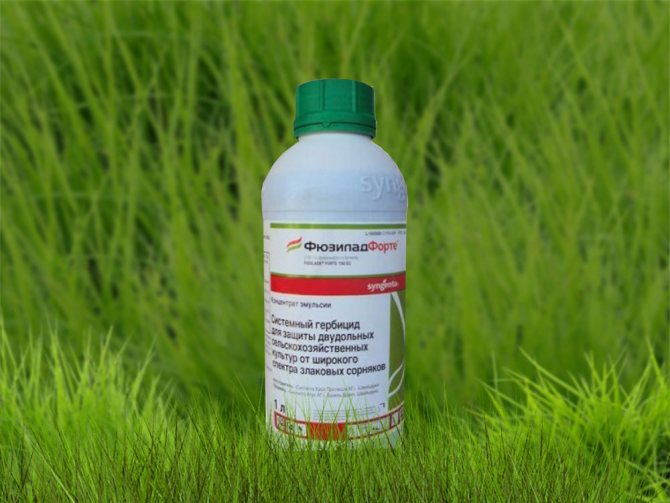

- Roundup. Approved by the Ministry of Health and the Ministry of Ecology of the Russian Federation. It is considered harmless to cultural plantings and the environment, but has a detrimental effect on the development of creeping grass. Contains glyphosate - the substance penetrates deeply into the soil and completely destroys a perennial weed in two months.
- "Hurricane Giant". The chemical infects all plants of this species, is sold in hotel doses for large areas and small vegetable gardens. As a rule, one treatment is sufficient, optionally urea is added to the solution.
- "Tornado", "Ground", "Fuzilad" other. After treatment with these agents, the weed withers in a week. They not only destroy the "harmful" grass, but are also good for preventive purposes.
EM preparations of biological effects are sprayed onto the site, substances are not toxic, contain microorganisms that feed on weeds.
In addition, the soil is enriched with nutrients and becomes more fertile. The following means of influence are known from this category: "EM-molasses", "Revival", "Shining", etc.

